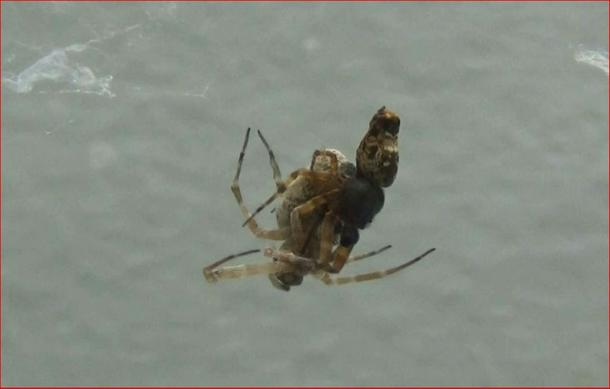
This handout photo provided on April 25, 2022 by Shichang Zhang of Hubei University shows two Philoponella prominens spiders mating
Washington (AFP) - Sometimes there are pretty valid reasons for leaving right after sex.
A team of Chinese scientists has discovered that male orb-weaving spiders fling themselves away from their partners – pulling 20 Gs of acceleration in order to avoid being killed and eaten by females.
The mechanism, described for the first time in the journal Current Biology on Monday, involves the spiders’ first pair of legs to immediately undertake a split-second catapult action.
Lead author Shichang Zhang of Hubei University in Wuhan told AFP he was “excited” to make the discovery, which required high-speed, high-resolution cameras to detect.
Zhang and colleagues were studying sexual selection in this spider, “Philoponella prominens,” which live in communal groups of up to 300 individuals.
Of 155 successful matings, they found 152 ended with the male catapulting and thus surviving the encounter.
Males can mate up to six times with the same female – bouncing off, climbing back up using a silk safety line, mating, and bouncing off again.
The three males that didn’t catapult were promptly captured, killed and consumed by their partners.
Another 30 males that were prevented from catapulting by placing a fine brush behind their dorsum all met the same fate – leading the researchers to conclude catapulting is essential to avoiding sexual cannabalism.
“Currently, I do not know whether there is any other species can also perform the catapulting,” said Zhang, adding he planned to investigate further.
Sexual predation by females is seen across many spider species, with various strategies for avoiding it: male nursey web spiders, for example, tie their partners up before mating.
- A suitable mate -
The escaping orb-weaving spiders clocked some impressive statistics: their average peak speed was 65 centimeters per second, with an acceleration of 200 meters per second squared. That’s equivalent to 20 Gs, or 20 times the acceleration felt during freefall.
While soaring through the air, the males spin around at some 175 revolutions per second.
The males catapult by folding the tibia-metatarsus joint of their first leg pair against females. When released, it exerts hydraulic pressure and causes the legs to expand.
Zhang said he believes the females were judging males’ sexual suitability by their ability to escape.
“Through the catapulting, a male can escape female sexual cannibalism, and a female can choose males with high quality, because the kinetic performance may directly correlate with male’s physical condition,” he said.
Even though they have already mated, females may go on to only accept the sperm of males that passed the test, explained Zhang.
Spiders differ from mammals in that females have a structure known as spermatheca where deposited sperm is stored. They can decide whether to use it to fertilize eggs, or reject it by squeezing it out or changing the pH value to kill the sperm.
Future work will confirm whether there is a correlation between male catapulting and reproductive success, said Zhang.